
Stone Washington
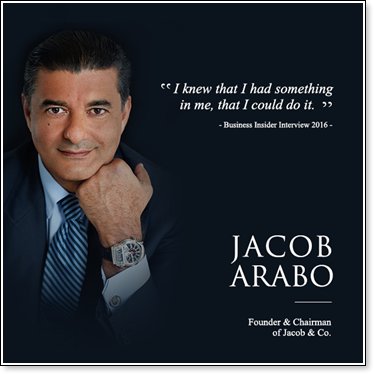
“A creative adult is a child who survived.” ~ The MB&F perspective on creativity.
“Respected by his peers for the quality of his work and his discoveries, Christophe Claret is writing some of the finest chapters in the history of 21st century watch making.” ~ Bold Acclaim of watchmaker Christophe Claret.
"You do that, I'll do this." ~Jacob Arabo, founder of Jacob & Co.
Prologue to Creative Horology of the 21st Century
Modern watchmaking has revolutionized the way we envision time. The 21st century has received a host of legendary watchmaking luminaries that have pushed the boundaries of possible in timekeeping. Where the old guard of horology included classical timepieces crafted by the likes of Graham, Breguet, Vacheron Constantin, Bovet, Audemars Piguet, and Patek Phillipe, there have emerged a number of new-generation, uber-innovative watch brands that have reshaped how watchmaking is conceived. These brands were established by avant-garde visionaries in the 1990s—2000’s, seeking to introduce unique mechanisms never considered to be associated with wrist-watches. Among the most prominent of watchmaking mavens of today stand three distinguished brands: Jacob & Company, Maximilian Büsser & Friends (MB&F), and Christophe Claret. Each company has expanded the contours of watching making excellence by introducing a peculiar and revolutionary new form of capturing time on one’s wrist.
These firms were established by visionaries that either broke away or never conformed to the traditional schools of watchmaking. Yet, at the same time, each of these brand’s captures the brilliance of the classical era design of horology as benchmarks to propel creative new developments. In essence, they combine the best of both worlds by fusing classical frameworks and mechanical elements from the 20th century (and prior) watchmaking with innovative mechanisms and extravagant complications unseen before. This culminates into truly unique and bold timepieces, such as Jacob & Company’s “Astronomia”, MB&F’s “Legacy Machine Sequential Evo”, and Christophe Claret’s “X-TREM.” This article will continue my exploratory series on watchmaking by examining these three modern innovators and highlighting some of the most ground-breaking watches they’ve devised. This piece will explore many of the most modernized, mechanized, and cutting-edge watches that define 21st century horology.
The Ascension of Jacob & Company
Jacob & Company is a modern luxury watch boutique established in 1986. The brand was founded by Jacob Arabo (born Jacob Arabov), a Bukharian Jew born in Uzbekistan while under Soviet Russia. Arabo developed an early admiration for working with fine jewelry at a young age, having assisted his four older sisters repair their personal jewelry. Additionally, Arabo took advantage of photography courses as a young boy which developed his keen eye for the scope and scale of fine jewelry. The design principles harnessed from this enabled him to develop a heightened aesthetical understanding of watches, fine gems, and precious metals. His fascination for watches began to bloom when his father gifted him with his personal wristwatch at the age of 13. The timepiece was a Greenwich Mean Time (GMT), meaning it could display and keep accurate account of two time zones simultaneously. It is from his first watch that Arabo describes his inspiration for crafting time zone complications, including Jacob & Company’s distinguished five time zone watch,
“It had two mechanical movements and that's where the idea for the five time zone watch came from. During my apprenticeship, I learned how to take a watch apart, how many parts there were, and it really moved me how complicated even a simple watch was,” according to Arabo. “For me, I fell in love with watchmaking right then and there, and I started dreaming of making my own watch. My experience there inspires me and drives me still today.”

Many high profile celebrities, including Jay Z, 50 Cent, Pharrell, and Busta Rhymes have been seen styling one of the Arabo’s Five Time Zone pieces. Even sports stars like David Beckham would style Jacob & Co timepieces prior to becoming major brand ambassadors of other watch companies, such as Tudor. The watch is perfect for the avid traveler or constant explorer, providing you with a constant sense of the time in your home country relative to your host country and other intended destinations.
Arabo later landed a factory job making $125.00 an hour assembling watches for sales by a large company. His skills in reconstructing jewelry for his four sisters came in handy here. Yet, he knew that his capabilities for fine watchmaking were above this position and yearned to establish his own brand. He eventually established his own company as a side hustle out of his bedroom. It is here that Arabo began to manufacture his own watches, design unique timepieces and attract an eccentric clientele that would pay him more than his factory job.
After quitting his factory position, Arabo established a permanent location for his business in the diamond district of New York City, along 47th street. Using his versatility, Arabo catered to regular jewelry orders for industry partners, while crafting specialized and custom gold pieces for high-level clients. By the age of 21, Arabo operated under the Jacob & Co brand name while also running a smaller retail jewelry boutique. He would later expand and build a firm location in Geneva Switzerland. Jacob & Co achieved national acclaim in the 1990’s and broke ground in 2002 when becoming the first major watchmaker to craft diamond-studded men’s watches. In this way, Arabo retained his special touch with diamonds and fine jewelry, which would continue to carry a notable effect the outward design for some of his best pieces.
Method to the Madness: Jacob & Co—Quenttin
The breakthrough mechanical masterpiece for Arabo was the Quenttin watch of 2006. The watch’s conceptual design was envisioned by the combined genius of Matthias Buttet—who would later become the technical director under legendary watchmaker Franck Muller—Enrico Barbasini, and Michel Navas (all of whom would work for Muller). These men headed the former Swiss manufacturer BNB Concept, a firm established specifically to produce high-end and exceptional watch movements. They catered to other top notch modern watchmaking firms, including Bell & Ross, Hublot, and DeWitt, each of which leveraged the firm to unveil unparalleled marvels in timekeeping. As such, these men were perfect for framing the groundbreaking watch that Arabo had in mind.
The Quenttin sports a unique semi-tonneau/square bezel, fit with a brilliantly designed vertical movement. The face is fully open to the inner mechanisms of the watch, showcasing a unique upper row befitting a complex set of seven miniature bicycle chains in rose gold. These give centrifugal force to the lower row that displays an alternative approach to timekeeping. This is where the watch captures accurate time with the caveat of using an unorthodox means for tracking time outside of the hour/minute hands and Roman numerals. For the Quenttin, this equates to three rotating slides revealing rotors with stationary bars corresponding to the exact seconds, minutes, and hour of the day.
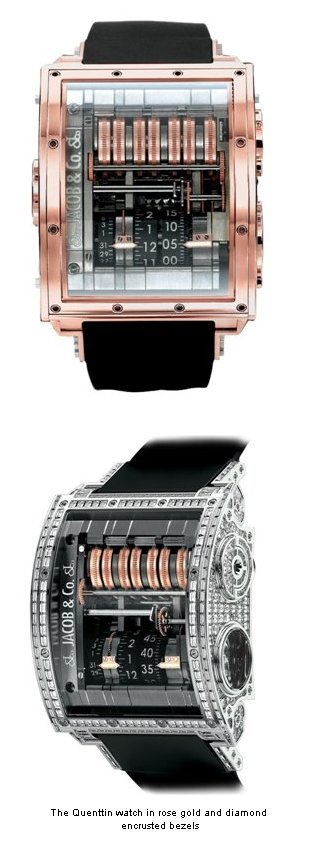
Among the most unique complications housed in the Qutenttin is the laterally placed tourbillion fitted in the side of the watch. One can see the tourbillion by looking through a small window on the side bezel. Traditionally, tourbillions were used to enhance the accuracy of the watch, and continue to do so today. Yet, for many watches, including this one, tourbillions are retrofitted into unique pieces to enhance the watch’s inward complexity and provide it with a “wow factor.” The Quenttin thus possesses several notable complications that launched Jacob & Co into a position of modern excellence.
Astronomically Astounding: Jacob & Co.—Astronomia
Following the Quenttin is the Astronomia watch, an astronomical marvel of modern horology. Jacob & Co Astronomia represents the greatest intergalactic themed mechanism ever to be captured and synthesized into a timepiece. The watch essentially represents the center of our solar system in miniature, providing an elaborate axis that carries three planetary bodies. One side carries a miniature earth, while the opposite prong carries the moon, and the sun on another end. The fourth and final prong carries the movement of the watch, retrofitted to rotate counterclockwise with the rest of the planetary bodies to resemble the effect of cosmic rotation in space. Rather than the earth and moon orbiting around the sun, all three orbit together with the watch movement around the edges of the timepiece to signify that all planets and cosmic entities are subject to the laws of space time.
Mankind’s discovery and understanding of our solar system is based on measurements of time—the earth’s timed rotation around the sun, the moon’s rotation around the earth, the cyclical timing of the alignment between all three bodies during an eclipse, and so forth. As such, Jacob & Co Astronomia captures these elements in a stunningly beautiful manner, while providing a complication within a complication: a self-rotating mechanism exhibiting solar-like qualities.
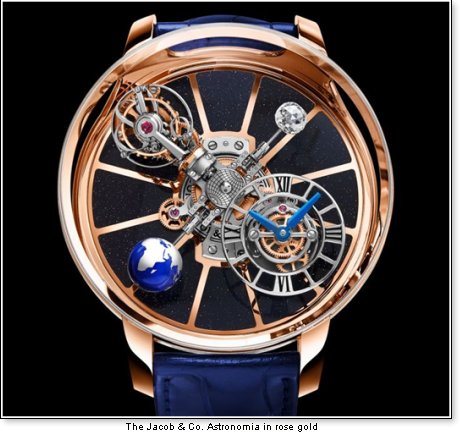
For exactly 10 years, the Astronomia has captured the sophistication of a revolving tourbillion onto its rotating platform, with one entire rotation lasting 20 minutes. The earth and moon each spin on their own axes for 60 seconds respectively. Arabo discovered a way to uplift the tourbillion’s normally stationary cage to float and rotate alongside the orbiting planetary miniatures without succumbing to the counter-rotations of the platform. In speaking to the inspiration for this highly sophisticated spectacle, Jacob & Co website reads,
“Celestial bodies and space exploration have long driven Jacob Arabo's creativity. In 2014, he translated his intimate passion into an ambitious timepiece concept. Astronomia Tourbillon is an unheard-of translation of astrophysics into watchmaking form. It is a wrist-sized model of a planetary system and its constant motion. Creating a miniature, mechanical solar system required going beyond all preconceptions, innovating and breaking barriers, like space exploration. Caliber JCAM10 [Astronomia] is one of the most advanced and complex movements in the Jacob & Co. catalog.”
The watch runs on an intricate automatic movement that houses a 60-day power reserve. Its uniquely stellar design captures a rare sense if awe and wonder for modern watchmaking, evoking something of a once-in-a-lifetime discovery housed onto one’s wrist. Arabo would later perfect the many complications that go into each Astronomia, unveiling a series of specialty variants that expand beyond the original Astronomia. These include the “Astronomia Tourbillon Art Dragon Rose Gold Sky”, the “Astronomia Revolution”, and the “Astronomia Solar” watches, each exhibiting their own special variation and style.

“Two Fast, Two Furious”: Jacob & Co.—Twin Turbo Furious
Lastly, no assessment of Jacob & Co would be complete without assessing the company’s expression of fast and furious racing in timekeeping: The “Twin Turbo Furious”. This watch carries dual high-level complications, designed to be evocative of the Italian hyper car luxury brand Bugatti. The watch operates on manual movement, carrying a 48-hour power reserve and a rare variation of a chronograph functionality with a special mono-pusher (normally chronographs possess two or more pushers) that regulates a column wheel within the watch. Given that it is a race-inspired timepiece, the chronograph helps keep track of elapsed time using seconds and minutes as controlled by a hidden pusher within the winding crank on the watch’s right-side.
The most notable feature is the watch’s exceptional twin flying gyro-tourbillions fitted at the 7 o’clock and 5 o’clock hours. Given that they are gyro-tourbillion, they rotate on three axes to provide a spectacular three-dimensional effect in the movement. Additionally, they “fly” due to their being no upper-bridge suspension above the tourbillion, hoisted only by the lower-end of their cage. The 832 inner mechanisms/components are forged of steel and titanium, while the outward bezel combines rose gold and black ceramic.
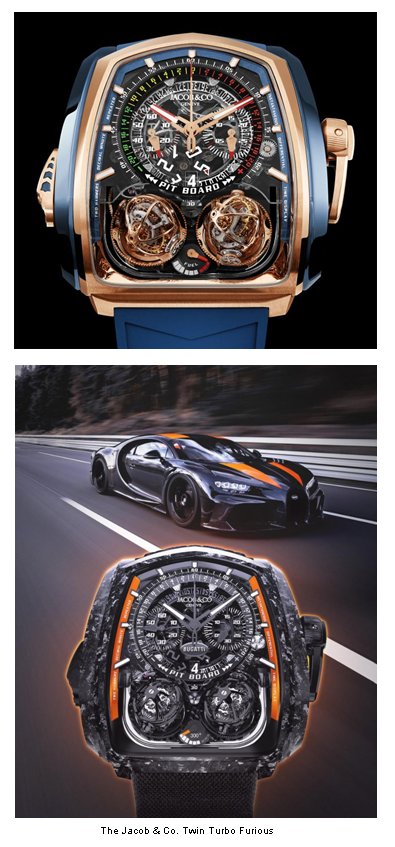
In addition to the sheer rarity and years of difficulty synthesizing two flying gyro-tourbillions into one watch, the Twin Turbo Furious carries an additional hyper complication. This is the watch’s decimal minute repeater that plays Cathedral music using gongs and chimes. Music is played acoustically as intervals of time pass, with musical scores played every 15 minutes and hour. Franck Muller and other prominent watchmakers have denoted the minute repeater as being among the most complex and difficult complications to synthesize into a watch. Accordingly, it is said that “only the most skilled and experienced watchmakers are able to master this complicated mechanism. It takes craftsmen several weeks to assemble the hundreds of components necessary for a single minute repeater.” Jacob & Co not only fitted an already hyper complicated watch with a minute repeater, the Twin Turbo watch performs a triple-layer of chimes every hour, chimes every ten minutes following the hour, and chimes on the final remaining minutes on the hour. This goes above and beyond a traditional minute repeater, providing 14 strikes.
These extraordinary elements working harmoniously together landed the Twin Turbo Furious in the grand complication territory of highly superb watches.
Origins of MB&F
Following Jacob & Co is another watch that defies the boundaries of possible in modern watchmaking excellence: MB&F. The company predominantly manufactures watches and to a lesser extent clocks. While Jacob & Co began in America, MB&F’s roots are in the heartland of watchmaking, having been founded by Swiss businessman Maximilian Busser in July 2005 in Geneva Switzerland in 2005. Busser carries an air of prestige and knowledgeableness of managing existing high-end watch brands, having led Harry Winston (1998-2005) and Jaeger LeCoultre (1991-1998) for seven years each prior to establishing his own brand. Busser was recruited to uplift both companies amid the industry wide struggle to compete with the new line of Quartz-powered watches (following the “Quartz crisis” of the 80’s). Despite having the opportunity to serve as an executive at larger, more financially lucrative corporations, Busser instead chose to occupy a bigger presence to elevate these Swiss watch boutiques.
In a 2016 NY Times exclusive, Busser recalls an important piece of advice he received from Henry-John Belmont, his mentor and outgoing CEO of Jaeger LeCoultre, regarding his approach to managing a small watch firm v. a large commercial enterprise like Proctor & Gamble: "Do you want to be one among 200,000 in a big corporation, or do you want to be among the four or five of us who can save this beautiful company?” Upon assessing the bigger picture and where he could make a greater impact, Busser chose the latter option. He was instrumental in reversing the crisis that many longstanding watch companies faced relative to up-and-coming Quartz alternatives. Busser used this as motivation for the wildly successful relaunch of Harry Winston Inc., having transformed their declining revenue stream of $8 million to $80+ million (a ten-fold increase). Harry Winston is an old-money watch company, established in 1932 by its founder of the same name. Like Jacob & Co, Harry Winston was well respected for his fine jewelry and precious diamonds, often esteemed as “the King of Diamonds” for his inventive fusion of extraordinary diamonds and high-octane functionality in watchmaking.
MB&F grew as a concept inspired by the highly sophisticated line of Harry Winston’s mechanical watches within the “Opus collection”. This collection housed some of the rarest, most complex watches within the company that rivaled that of other prestigious watchmakers. The goal was for Winston to attract elite watchmakers to produce exclusively unique pieces that the company would promote. Opus was described by writer Elizabeth Doer as an “ultra-limited annual edition,” which “revolved around cooperating with an outstanding independent watchmaker each year to create a signature edition of timepieces.” While CEO of Harry Winston Inc., Busser took the Opus to new heights, using it to inspire his own line of rare of watches. According to Doer, Busser made the most of his high-level “energy, ideas, and a deep-seated passion for unusual haute horlogerie – traits he took with him when he founded his own company, MB&F.” Among the greatest of Busser’s creations is the “Space Pirate.”
MBF Space Pirate (aka Horological Machine No. 6)
The Space Pirate evokes the futuristic design and next-century vision of Busser’s unique style. This collection is limited to an average of 16 pieces (watches) per 5 limited editions. It speaks volumes for the company’s distinctive contribution to horology, representing one of the most space-age wristwatches ever envisioned. Taking horology into hyperspace, the Space Pirate’s entire biomorphic design is an unparalleled complication, shaped like a silver spaceship carrying four pods. Each pod contains a special function of the watch, housed within a spherical 360 case of sapphire crystal domed covers. The domes at the bottom of the watch showcase large displays of the minutes and hour, while the two domes at the top showcase aspects of the watch’s automatic movement.
The specialized automatic movement encompasses spinning, spherical turbines, which provide aesthetic appearance, while managing the automatic winding of the watch, mitigating the effects of wear and tear over time. The biomorphic, spaceship frame is comprised of grade-5 (high-level) titanium, making it very capable of enduring even the most severe physical damage. The most apparent complication beyond than the other-worldly shape and turbines is the large flying tourbillion housed within a pod of the watch’s center, fitted with a retractable shield that can protect the domed display. The ship’s alluring biomorphic design is taken from the biomorphism art form (design based on living organisms), while the inspiration for an alien-like ship derived from Captain Flam’s spacecraft in the 1970s Japanese Anime Capitaine Flam.
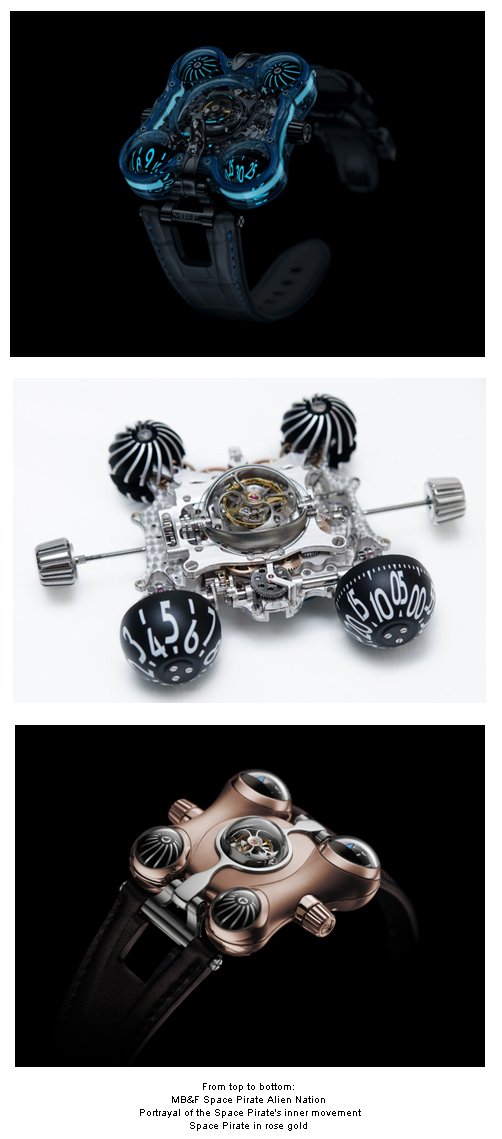
The H11 Architect—by MB&F
Where the Space Pirate evoked biomorphic, space age design and function, MB&F’s “The Architect” watch carries a very special architectural design retrofitted into a portable watch. The alternative name invokes this characterization, in addition to the peculiar frame of the watch resembling something of a 1960’s space-age building. Like many of his watches, the Architect elevates Busser’s vision for next-level, futuristic qualities in watchmaking. This gives the appearance of otherworldly travel or the impression that his watches are built from the future. Where Jacob & Co provides watches that envelop avant-garde functionality and layered complications that evoke widespread amazement, MB&F’s designated watches (or “machines”) embody eye-catching futurism designs and focus primarily on a formerly unexplored mechanical concepts that are later retrofitted into a watch.
The Architect’s shape, while different than the Space Pirate, follow a similar structure with the four corners carrying four windows into the core complications and functions. One window displays the hours/minutes, another the power reserve, a temperature gauge, and a distinctive beveled crown at the traditional 3’oclock position. The soul of the Architect is contained in a flying tourbillion, mounted in the center of the watch within a dome similar to the Space Pirate. The watch stores a massive 96-hour power reserve, and the entire bezel can be twisted to generate kinetic energy (rather than twisting the crown).
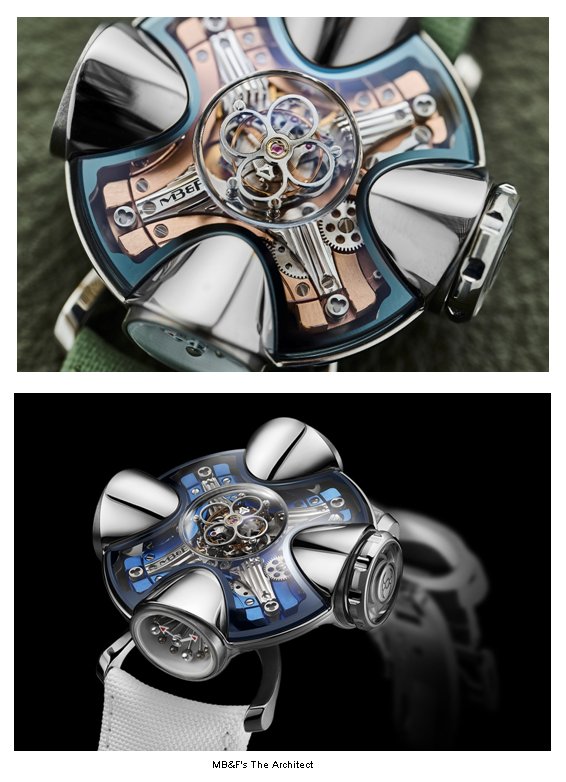
LM Sequential Evo—MB&F
The third and final watch to highlight among MB&F’s incredible collection is the Legacy Machine (LM) Sequential Evo. This watch provides a dual complication with intersecting chronographs and interlocking gear mechanisms that work harmonically to keep track of multiple time intervals simultaneously. By this, the wearer can use one chronograph to track elapsed minutes, activate a “Twinverter” switch at the 9 o’clock hour to start the other chronograph’s elapsed seconds counter, while instantaneously pausing and returning to zero the first chronograph. The LM Sequential Evo follows MB&F’s advanced development of horological complications, taking two different chronographs that move at varying frequencies and connecting what would normally be separate stop/start functions. Busser attributes the idea and construction of the LM Evo to Stephen McDonnell, who collaborated with Busser to discover a more efficient method for keeping elapsed time across different intervals simultaneously. Instead of the impracticality of needing to wear three different chronographs at once, Busser and McDonnell synthesized the precision of two chronographs into one precise, inverted movement. The result is a highly complicated watch with 585 interlocking components and four pushes, including special levers and clutches that activate the Twinverter mechanism.
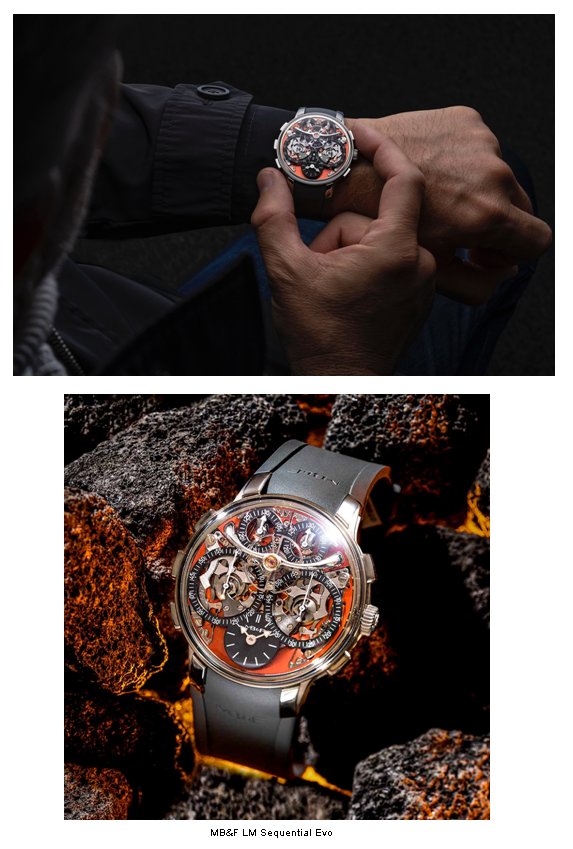
Christophe Claret—Genius among Giants
Last but not least is the self-proclaimed watchmaking perfectionist and high-level innovator in modern timekeeping: Christophe Claret. Claret is a lesser-known watchmaker compared with household names like MB&F and Jacob & Co. His watches are mostly known to a subset of elite aficionados and wealthy patrons who have an appetite for unusual and high-powered watches. Claret uses a simple, spontaneous approach to craft his own variety of cutting-edge watches. According to the company website, Claret’s mission is “that of meticulously crafting the most complicated possible movements. Respected by his peers for the quality of his work and his discoveries, Christophe Claret is writing some of the finest chapters in the history of 21st century watchmaking.” Indeed, Claret has broken boundaries to write some of the defining chapters of modern watchmaking, showcasing select pieces that go so far as to redefine what we know about timekeeping.
Like Jacob & Co founder Jacob Arabo, Claret was exposed to and taught to appreciate fine watches during his youth. While 14, his parents gave him a fieldtrip to a watch restoration shop, where he saw first-hand the painstaking, arduous process of a mechanic’s efforts to restore a watch. From this, Claret developed an appreciation for not only restoring formerly broken watches, but developing ideas for how to elevate watches to new heights through the repair process. Claret would attend the Geneva Watchmaking School and excel at the fundamentals of fine watches, honing the elements of Swiss craftmanship. His schooling paid off when he obtained an apprenticeship under the great Roger Dubuis, revered for his high caliber luxury watches and extraordinary skeletal watch designs.
After some years under Dubuis, Claret would break away and exercise his own entrepreneurial insights by establishing his own workshop in Lyon Switzerland. It was here that Claret returned to his specialty of watch restoration, further developing the process of regenerating old, beaten, or broken timepieces into renewed, beaming, and stylish watches. Regeneration is Claret’s guiding star, and the process of improving watches from his workshop would blossom into an art form.
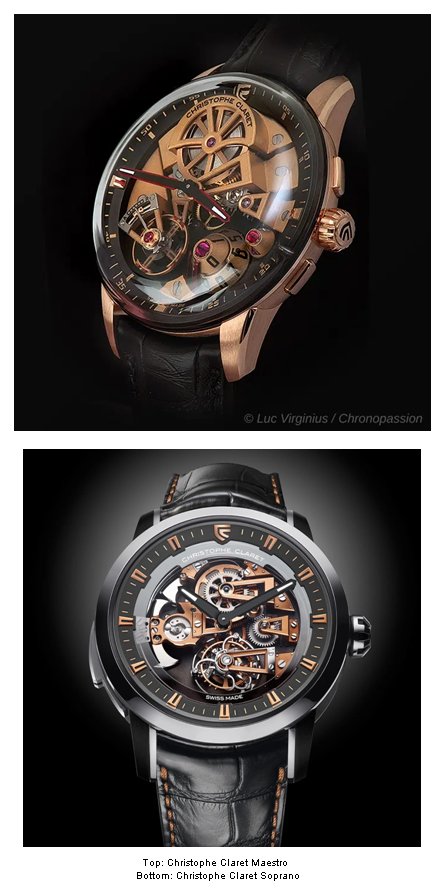
According to Revolution Magazine, Claret would establish a manufacturing hub for supplying other top watchmakers with hard to come by components to supplement their watch movements. Accordingly, Claret “became a supplier of complicated movements to other watch brands starting in 1989, with the San Marco minute repeater, for Ulysse Nardin. [Capitalizing] on this momentum, in 1989, Mr. Claret founded the Claret manufacture in La Chaux-de-Fonds, Switzerland.” Claret quickly established himself as a reliable restorer and manufacture of fine, Swiss watches for some of the biggest names in modern watchmaking. Claret’s ascension from observing watches undergo restoration in a small workshop to running a lucrative manufacturing center under his name embodies a similar drive to success displayed by Arabo and Busser.
X-Trem 1 – Pushing the Boundaries of Extreme
The X-Trem 1 represents a modern marvel of watchmaking. Housed within a unique, rectangular bezel, Claret showcases his most impressive set of grand complications using sheer elegance, ingenuity in design, and unrivaled boldness. Like the Jacob & Co Quenttin, the X-Trem 1 uses a uniquely alternative means of capturing and keeping time. It does so by etching bold hours (1-12 o’clock) in rose gold on the left side and minutes (0-60) on the right side of the watch. Attached to each side is a cage that contains a small magnetic ball. Each ball is levitated up the tube at a rate corresponding with the natural passage of time. The balls keep track of the hours and minutes as they gradually are pushed up the tube. Once they reach the top of the 12 o’clock hour or 60-minute mark, the balls plummet to the bottom from a reverse magnetic propulsion.
Claret redefines traditional standards of timekeeping using incredible applications of magnetic fields through physics, all while retaining the elegant quality of a well-designed timepiece. Perhaps the most astounding marvel is that magnetism normally disrupts the accuracy of timekeeping. Yet, Claret somehow invented a way for the watch movement and the magnetic displays to work in harmony, undisrupted by each other. The amazement doesn’t end there, as the watch showcases a grand complication unlike any other brand: its own signature tourbillion, angled below the 6 o’clock hour. Most watches are incapable of angling the tourbillion on the outer bezel of the watch, and very few like Gruebel Forsey and MB&F, are capable of angling the tourbillion from within the watch. Claret achieves something truly unique in watch design and functionality, utilizing countervailing forces for timekeeping and unorthodox design principles to accommodate a grand complication.
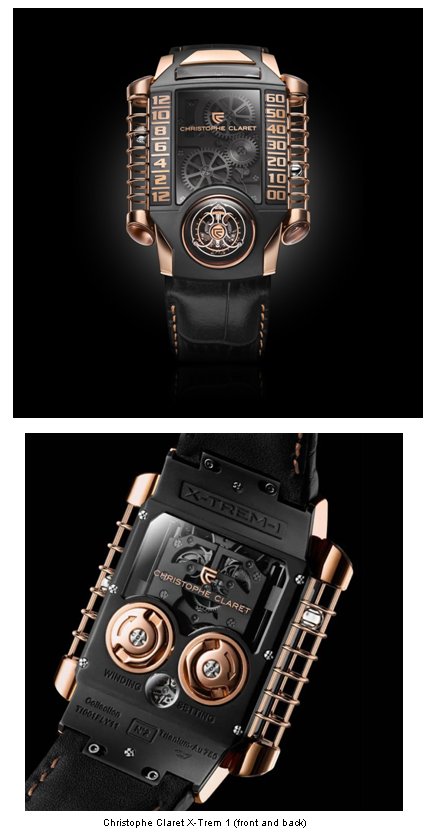
Closing Reflections on Modern Watchmaking
This article showcases three notable watchmaking brands for setting the precedent for how 21st century watches operate, forever changing the game. Each company provides a specialized and highly inventive approach to telling time outside of the conventional methods of old. Jacob & Co produces avant-garde, watches that showcase some of the most creative array of layered complications. Arabo’s brand inspire a rare sense of awe and fascination among those fortunate to behold these up close. MB&F utilizes both form and function to introduce bizarrely unique, and far-out designs resembling unseen mechanizations from the future. Busser’s company masterfully uses space-age, machine-like collections to produce watches that are beautifully complicated beyond measure. Lastly, Christophe Claret’s bold vision for restoration helped inspire the boldest collection of grandly complicated watches. Utilizing a cadre of sophisticated materials used in other top brands, Claret establishes his company as a subtler, yet comparably innovative contender and a modern maverick of horology.
Each of the three brands carries a special and intertwined backstory on how these once unknown, niche watch boutiques exploded into internationally renowned trend-setters of luxury watches. Two unifying themes amongst the three is their appeal to high-quality sophistication in a watch’s movement and the never-ending pursuit to craft watches that adapt to incredibly unique forms. Each brand has redefined what is possible in watchmaking: a hallmark to the modern era. MB&F even contributed to the resurgence of classical watchmaking movement (automatic) in the face of the Quartz crisis, by producing high-level watches that no Quartz manufacturer could ever dream of. Watchmaking remains an important craft and art form no matter the age or era. It is thanks in large part to the creative ingenuity and path-breaking boldness of these three watch firms that dared to redefine the possible in horological excellence.
© Stone WashingtonThe views expressed by RenewAmerica columnists are their own and do not necessarily reflect the position of RenewAmerica or its affiliates.


















